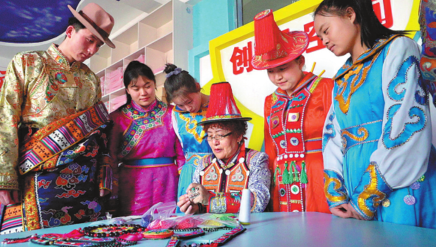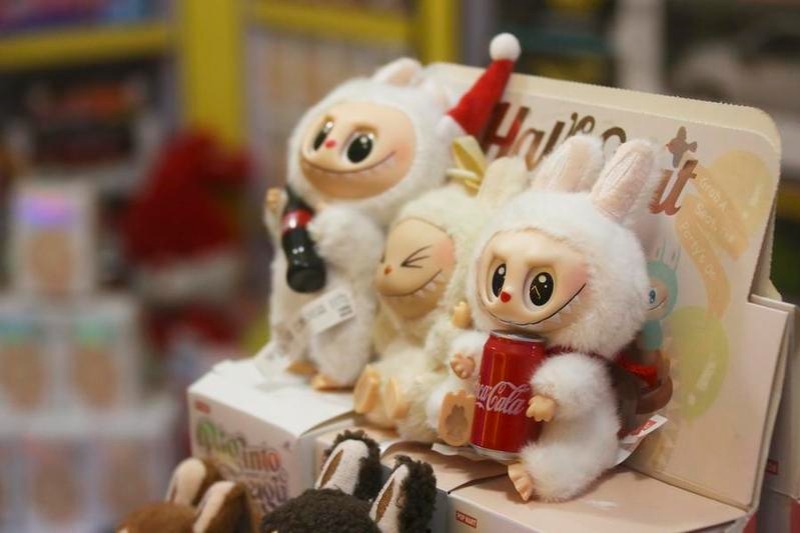Yugur craftsmanship thrives with delicate touch

LANZHOU — During recent festivities to celebrate the 70th anniversary of Sunan Yugur autonomous county in Gansu province, the nomadic Yugur people's unique ethnic attire was an attraction in its own right.
With a population of more than 10,000, the Yugur primarily reside at the foot of the Qilian Mountains. For generations, they have maintained their ancient customs, including traditional clothing. Beyond its time-honored functionality, the ethnic group's traditional attire represents a tangible piece of cultural heritage with significant market potential.
Yugur traditional clothing is characterized by high-collared, front-opening long robes, with distinctive patterns and hat styles that vary by gender and tribe. Among the most recognizable elements are the women's red-tasseled hats and elaborate headpieces adorned with turquoise, agate, pearls and coral.
These headpieces are typically handcrafted by mothers for their daughters and stay in the family as treasured heirlooms and dowries.
In 2008, Yugur traditional clothing was listed as a national-level intangible cultural heritage.
Ke Cuiling, 64, a master craftswoman and national intangible cultural heritage inheritor, has devoted her life to preserving the craftsmanship.
Starting at 14, Ke meticulously learned the intricate craft of Yugur clothing and embroidery from her mother and sister. Her passion for the craft's artistry has also led her to collect old embroidery pieces.
Yugur clothing is entirely handmade, with every stitch reflecting the maker's skill and dedication."My mother was incredibly skilled, able to twist thread as fine as a strand of hair," she recalls.
According to Ke, even with modern techniques, creating a single headpiece requires about 50 days of continuous work. Therefore, mothers would start making their daughters' wedding attire from birth.
In the 1990s, inspired by a foreigner's offer to buy her handmade wrist strap for $10 in Shenzhen, Ke began to explore the commercial potential of her craft. She established a studio, trained apprentices, and began making sales. Ke creatively applied Yugur patterns and embroidery techniques to everyday items like camera straps and pouches, which proved popular with customers.
Meanwhile, Ke continues to visit Yugur elders to collect and preserve clothing patterns and document craftsmanship processes, believing that even ancient items are part of Yugur culture.
The Yugur often spend considerable amounts on a set of clothing, with prices ranging from 6,000 yuan ($840) to more than 100,000 yuan.
Today, Ke has trained over 100 apprentices, and her family is actively involved in preserving Yugur cultural heritage. Her company's sales of cultural and creative products have increased by over 30 percent compared to last year.
In 2014, Ke opened a Yugur folk museum, attracting visitors and scholars from around the world.
The local government is also supporting efforts to preserve traditional Yugur clothing and embroidery through exhibitions, performances and workshops.
Over 200 exhibitions and performances and traditional craft training sessions have been organized, according to Zhang Anting, director of the county's intangible cultural heritage protection and inheritance center, adding that there are 14 national and provincial inheritors of Yugur crafts.
For 46-year-old Pan Xiaohong, who lost the use of four fingers on her left hand due to an accident during childhood, the craftsmanship of Yugur clothing opened new possibilities.
Through years of diligent study and strenuous training, Pan not only earns a living through Yugur clothing craftsmanship but also helps many people with disabilities support themselves through this skill.
Nowadays, Pan's embroidery company employs 43 workers, including 22 with disabilities.
Four years ago, her company focused solely on producing Yugur ethnic clothing. Today, the embroiderers have developed more than 100 cultural and creative products inspired by traditional patterns, with 15 of these products applying for design patents.
"Creating ethnic clothing is a calming process that brings a sense of accomplishment and confidence with each completed piece. Just as it has brought me more possibilities, I hope that through innovation while preserving tradition, I can create more jobs for others," says Pan.
Xinhua


Today's Top News
- Xi, King Tupou VI attend signing ceremony of cooperation documents
- Xi meets Tonga's king
- Xi sends congratulatory message to 7th China-Russia Energy Business Forum
- European leaders, WTO warn against unilateral tariffs, rising protectionism
- Japan blasted for ambiguity on Taiwan
- Thumbs-up to China for its life expectancy






























